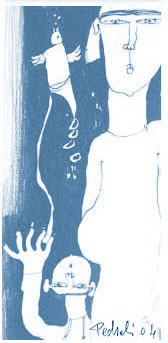Hot topics dalla letteratura internazionale
a cura di Edgardo Somigliana
Use of fertility drugs and risk of ovarian cancer: Danish Population Based Cohort Study.
Jensen A, Sharif H, Frederiksen K, Kjaer SK.
BMJ. 2009 Feb 5;338:b249.
OBJECTIVE: To examine the effects of fertility drugs on overall risk of ovarian cancer using data from a large cohort of infertile women. DESIGN: Population based cohort study. SETTING: Danish hospitals and private fertility clinics. PARTICIPANTS: 54,362 women with infertility problems referred to all Danish fertility clinics during 1963-98. The median age at first evaluation of infertility was 30 years (range 16-55 years), and the median age at the end of follow-up was 47 (range 18-81) years. Included in the analysis were 156 women with invasive epithelial ovarian cancer (cases) and 1241 subcohort members identified in the cohort during follow-up in 2006. MAIN OUTCOME MEASURE: Effect of four groups of fertility drugs (gonadotrophins, clomifene citrate, human chorionic gonadotrophin, and gonadotrophin releasing hormone) on overall risk of ovarian cancer after adjustment for potential confounding factors. RESULTS: Analyses within cohort showed no overall increased risk of ovarian cancer after any use of gonadotrophins (rate ratio 0.83, 95% confidence interval 0.50 to 1.37), clomifene (1.14, 0.79 to 1.64), human chorionic gonadotrophin (0.89, 0.62 to 1.29), or gonadotrophin releasing hormone (0.80, 0.42 to 1.51). Furthermore, no associations were found between all four groups of fertility drugs and number of cycles of use, length of follow-up, or parity. CONCLUSION: No convincing association was found between use of fertility drugs and risk of ovarian cancer.
Cumulative live-birth rates after in vitro fertilization.
Malizia BA, Hacker MR, Penzias AS.
N Engl J Med. 2009 Jan 15;360(3):236-43.
BACKGROUND: Outcomes of in vitro fertilization (IVF) treatment are traditionally reported as pregnancies per IVF cycle. However, a couple's primary concern is the chance of a live birth over an entire treatment course. METHODS: We estimated cumulative live-birth rates among patients undergoing their first fresh-embryo, nondonor IVF cycle between 2000 and 2005 at one large center. Couples were followed until either discontinuation of treatment or delivery of a live-born infant. Analyses were stratified according to maternal age and performed with the use of both optimistic and conservative methods. Optimistic methods assumed that patients who did not return for subsequent IVF cycles would have the same chance of a pregnancy resulting in a live birth as patients who continued treatment; conservative methods assumed no live births among patients who did not return. RESULTS: Among 6164 patients undergoing 14,248 cycles, the cumulative live-birth rate after 6 cycles was 72% (95% confidence interval [CI], 70 to 74) with the optimistic analysis and 51% (95% CI, 49 to 52) with the conservative analysis. Among patients who were younger than 35 years of age, the corresponding rates after six cycles were 86% (95% CI, 83 to 88) and 65% (95% CI, 64 to 67). Among patients who were 40 years of age or older, the corresponding rates were 42% (95%CI, 37 to 47) and 23% (95% CI, 21 to 25). The cumulative live-birth rate decreased with increasing age, and the age-stratified curves (< 35 vs. > or = 40 years) were significantly different from one another (P<0.001). CONCLUSIONS: Our results indicate that IVF may largely overcome infertility in younger women, but it does not reverse the age-dependent decline in fertility.
Clomifene citrate or unstimulated intrauterine insemination compared with expectant management for unexplained infertility: pragmatic randomised controlled trial.
Bhattacharya S, Harrild K, Mollison J, Wordsworth S, Tay C, Harrold A, McQueen D, Lyall H, Johnston L, Burrage J, Grossett S, Walton H, Lynch J, Johnstone A, Kini S, Raja A, Templeton A.
BMJ. 2008 Aug 7;337:a716.
OBJECTIVE: To compare the effectiveness of clomifene citrate and unstimulated intrauterine insemination with expectant management for the treatment of unexplained infertility. DESIGN: Three arm parallel group, pragmatic randomised controlled trial. SETTING: Four teaching hospitals and a district general hospital in Scotland. PARTICIPANTS: Couples with infertility for over two years, confirmed ovulation, patent fallopian tubes, and motile sperm. INTERVENTION: Expectant management, oral clomifene citrate, and unstimulated intrauterine insemination. MAIN OUTCOME MEASURES: The primary outcome was live birth. Secondary outcome measures included clinical pregnancy, multiple pregnancy, miscarriage, and acceptability. RESULTS: 580 women were randomised to expectant management (n=193), oral clomifene citrate (n=194), or unstimulated intrauterine insemination (n=193) for six months. The three randomised groups were comparable in terms of age, body mass index, duration of infertility, sperm concentration, and motility. Live birth rates were 32/193 (17%), 26/192 (14%), and 43/191 (23%), respectively. Compared with expectant management, the odds ratio for a live birth was 0.79 (95% confidence interval 0.45 to 1.38) after clomifene citrate and 1.46 (0.88 to 2.43) after unstimulated intrauterine insemination. More women randomised to clomifene citrate (159/170, 94%) and unstimulated intrauterine insemination (155/162, 96%) found the process of treatment acceptable than those randomised to expectant management (123/153, 80%) (P=0.001 and P<0.001, respectively). CONCLUSION: In couples with unexplained infertility existing treatments such as empirical clomifene and unstimulated intrauterine insemination are unlikely to offer superior live birth rates compared with expectant management.

